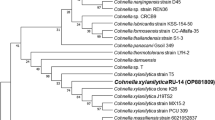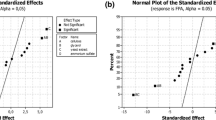Abstract
The present study aimed at maximizing cellulase production by Penicillium funiculosum using sequential experimental design methodology for optimizing the concentrations of nitrogen sources. Three sequential experimental designs were performed. The first and the second series of experiments consisted of a 24 and a 23 factorial designs, respectively, and in the third one, a central composite rotational design was used for better visualizing the optimum conditions. The following nitrogen sources were evaluated: urea, ammonium sulfate, peptone, and yeast extract. Peptone and ammonium sulfate were removed from the medium optimization since they did not present significant statistical effect on cellulase production. The optimal concentrations of urea and yeast extract predicted by the model were 0.97 and 0.36 g/L, respectively, which were validated experimentally. By the use of the desirability function, it was possible to maximize the three main enzyme activities simultaneously, which resulted in values for FPase of 227 U/L, for CMCase of 6,917 U/L, and for β-glucosidase of 1,375 U/L. These values corresponded to increases of 3.3-, 3.2-, and 6.7-folds, respectively, when compared to those obtained in the first experimental design. The results showed that the use of sequential experimental designs associated to the use of the desirability function can be used satisfactorily to maximize cellulase production by P. funiculosum.



Similar content being viewed by others
References
Pereira, R. E. (2006). MSc Thesis. Escola de Química. Universidade Federal do Rio de Janeiro
Pereira, N., Jr., Couto, M. A. P. G., & Anna, L. M. M. S. (2008). Series on biotechnology (2nd ed., p. 45). Rio de Janeiro: Biblioteca Nacional.
Vasquez, M. P., Silva, J. N. C., Souza, M. B., Jr., & Pereira, N., Jr. (2007). Applied Biochemistry and Biotechnology, 137/140(12), 141–154.
Schlitter, L. A. F. (2006). Msc Thesis. Escola de Química. Universidade Federal do Rio de Janeiro
Zabel, R. A., & Morrell, J. J. (1992). Wood microbiology, decay and its prevention. San Diego: Academic. 476p.
Marzluf, G. (1997). Microbiology and Molecular Biology Reviews, 61(1), 17–32.
Merrick, M. J., & Edwards, R. A. (1995). Microbiological Reviews, 59, 604–622.
Betancur, G. J. V. (2005). Msc Thesis. Escola de Química. Universidade Federal do Rio de Janeiro
Sluiter, A., Hames, B., Ruiz, R., Scarlata, C., Sluiter, J., & Templeton, D. (2005). NREL, 14 p.
Ververis, C., Georghiou, K., Danielidis, D., Hatzinikolaou, D. G., Santas, P., Santas, R., et al. (2007). Bioresource Technology, 98, 296–301.
Ghose, T. K. (1987). Pure and Applied Chemistry, 59(2), 257–268.
Mandels, M., & Weber, J. (1969). Advances in Chemistry Series, 95, 391–414.
Derringer, G., & Suich, R. (1980). Journal of Quality Technology, 12, 214–219.
Reyes, J., Peralta-Zamora, P., & Duran, N. (1998). Química Nova, 21(2), 140–143.
Sun, Y., & Cheng, J. (2002). Bioresource Technology, 83(1), 1–11.
Jorgensen, H., & Olsson, L. (2006). Enzyme and Microbial Technology, 38, 381–390.
Acknowledgements
The authors acknowledge the Brazilian Council for Research (CNPq), the Rio de Janeiro State Foundation for Science and Technology (FAPERJ), and the Brazilian Petroleum Company (PETROBRAS) for scholarship and other financial supports.
Author information
Authors and Affiliations
Corresponding author
Rights and permissions
About this article
Cite this article
Maeda, R.N., da Silva, M.M.P., Santa Anna, L.M.M. et al. Nitrogen Source Optimization for Cellulase Production by Penicillium funiculosum, using a Sequential Experimental Design Methodology and the Desirability Function. Appl Biochem Biotechnol 161, 411–422 (2010). https://doi.org/10.1007/s12010-009-8875-6
Received:
Accepted:
Published:
Issue Date:
DOI: https://doi.org/10.1007/s12010-009-8875-6




